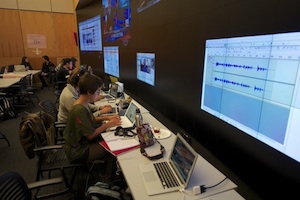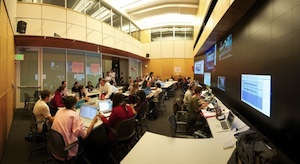Stanford U Display Wall Takes Visualization to a Higher Level
- By Dian Schaffhauser
- 10/06/14
Two years into the installation of a sizable multi-display wall, Stanford University is still finding new uses for it. In 2012 the institution updated technology in the 60-seat Peter Wallenberg Learning Theater, part of Wallenberg Hall, Stanford's "home" for research in university-level classroom learning. The update replaced a three-projector setup that could display a total of three individual simultaneous displays with a 32-foot-wide by 8-foot-high display wall. The goal was to make optimal use of the space, which includes a curved wall and hosts courses in journalism and social sciences, among others, and to make it as flexible as possible to accommodate usage that hadn't been thought up yet.
The newly furnished room includes high-resolution Christie MicroTiles that start two feet off the ground and form a seamless, curvilinear video wall that's 256-square-feet in size, spanning nearly the entire width of the room. The frame was designed by rpVisual Solutions. Each MicroTile is about 16 inches by 12 inches, and the gaps between the tiles are 1.3 millimeters. The tiles themselves have a 720 x 540 pixel display. The system is used as one massive display with 16 separate channels of display activity, managed by a Jupiter Fusion Catalyst 4000 controller.

Wallenberg Learning Center. Source: Linda A. Cicero, Stanford News Service. |
A 5.2-channel audio system can localize sound and sync them to specific images on the display. For example, if multiple people are shown on separate screens, the audio from each will be tied to their individual images and track them as the images move across the field of view.
In the previous generation of theatre, which used projectors to display images, the front row was often vacant because it provided a poor view of the display and because student heads would cast shadows on the screen. Bob Smith, director of technology services for the University Registrar, said the MicroTiles allow people to sit closer to the screen and "allow us to flexibly adjust the visual rhetoric of the screen, making important things bigger, less critical things smaller, bringing things to the center, and moving other things to the side."


Wallenberg Learning Center. Source: The Board of Trustees of the Leland Stanford Junior University. |
This isn't Stanford's first experience with the technology: Two years ago, a Christie MicroTiles video wall was installed in the university's visitors center. "From that installation, I knew the MicroTiles were gorgeous; they're so rich, and they're linear all the way down into the blacks. They're just really beautiful things," noted Smith.
Early on the updated Wallenberg space served as a working newsroom for journalism students who were covering the 2012 election. The wall displayed multiple feeds simultaneously.
"What you saw there was a sort of mission control application where there were seven different screens up there — including CNN — two local channels with picture-in-picture and closed captioning, the New York Times Web page, a Google analytics page, one person editing video and another sorting still images," recalled Smith. "It was the apotheosis of a group work scenario. There was information that was common to everyone in the room spread across the top of the screen. And, at the same time, people who needed some smaller group sharing the space or just a larger display area were working in very close to the screen but down low and using the MicroTiles as an extension of their laptop. That was a really fun, early use of the space."
The display wall is managed by users through an interface designed by Registrar staff, who wanted display screen controls that resembled the wall itself. The idea was to allow a user to walk up to the control screen and figure out how to manage the displays quickly without special training.
Smith said each class uses the wall in a different way, adding, "The result is that the MicroTiles have basically allowed us to take classroom visualization to a much higher level, with a much higher level of flexibility.... You've got something that is tremendously capable and very exciting with what the possibilities are."
About the Author
Dian Schaffhauser is a former senior contributing editor for 1105 Media's education publications THE Journal, Campus Technology and Spaces4Learning.